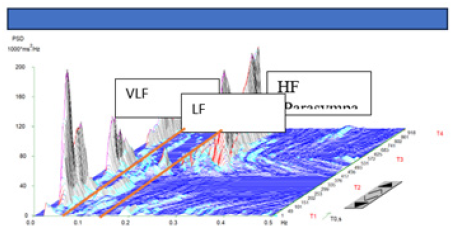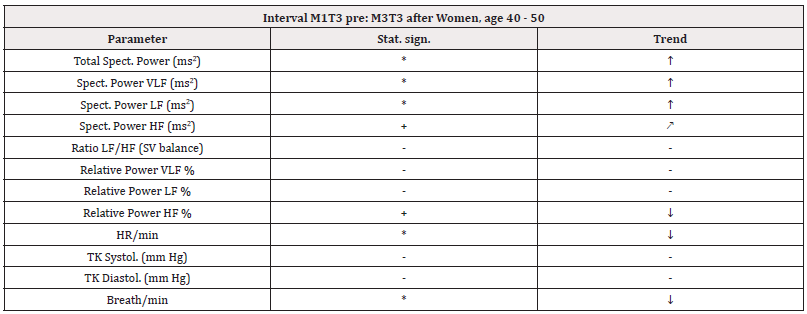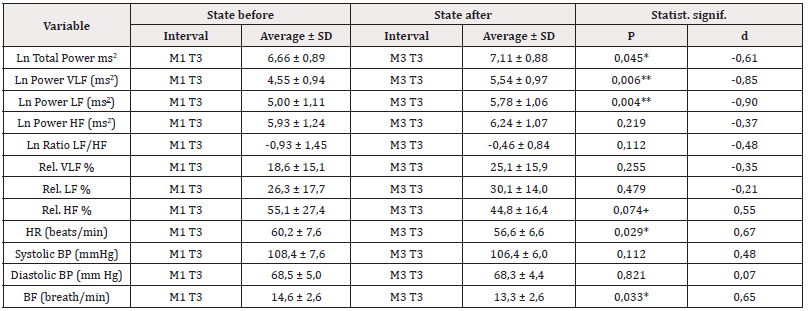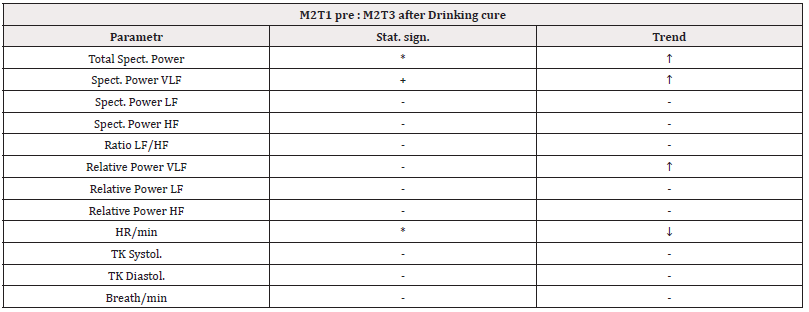Research Article 
 Creative Commons, CC-BY
Creative Commons, CC-BY
Influence of Carlsbad Thermo-Mineral Water on the Autonomic Nervous System
*Corresponding author: Petr Kolisko, Palestra College of Physical Education and Sports Slovačíkova 21, Prague, Czech Republic and Balneology clinic, Hotel Prezident, Moravská 3, Karlovy Vary, Czech Republic.
Received: May 15, 2024; Published: June 10, 2024
DOI: 10.34297/AJBSR.2024.22.003016
Introduction
The drinking cure is an essential part of Karlovy Vary spa treatment. The effects of the Karlovy Vary thermo-mineral water are described by a number of authors (Benda, 1997; Třískala and Jandová 2019; etc) [1,2].
The effect of Karlovy Vary mineral water on the autonomic nervous system has not yet been investigated. Based on case analyses, we hypothesized that the effects of the drinking cure have an effect on the functional activity of the autonomic nervous system.
Research Questions
a. Will there be a significant increase in the total functional activity of the autonomic nervous system (Total Power) in the interval of 30-50 minutes after the application of the drinking cure with Karlovy Vary thermo-mineral water?
b. How will these changes affect the sympathetic (Spectral Power LF) and parasympathetic (Spectral Power HF) activity?
c. Will there be changes in systolic and diastolic blood pressure and heart rate in the interval of 30-50 minutes after the application of drinking cure?
d. Will there be changes in the total spectral power (Total Power), during the application of the drinking cure in M2T2 interval?
e. Will there be changes in sympathetic (Power LF) and parasympathetic activity (Power HF) and changes in the sympathetic-vagal balance (Ratio LF/HF), during the application of the drinking treatment in M2T2 interval?
f. Will there be changes in systolic and diastolic blood pressure and heart rate during the drinking course in the M2T2 interval?
Methodology
The prospective research study had the character of an experiment in clinical conditions.
Research File:
Healthy women, age 40-50 years, n=15. The test subjects met the pre-determined criteria for the examination (good health, no medication or nutritional supplements, non-smokers, examination in the morning on an empty stomach, 24 hours before examination only light physical load only, etc.).
The length of individual T intervals in individual measurements M1, M2, M3 was 300 heartbeats
During the measurement, the following physiological parameters were monitored:
i. The functional status of autonomic regulation of heart activity by the method of spectral analysis of heart rate variability
ii. Blood pressure values (were monitored repeatedly 4x during each interval)
iii. Respiratory frequency values (frequency/min.) were monitored during the entire experiment.
Case Analysis
Healthy women 42 years.
Graphical protocols of Spectral Analysis of Heart Rate Variability (SAHRV). Measurement M1, M2, M3.

Figure 1: State before drinking cure:(measurement M1) T1-clinostasis, T2-ortostasis; T3-2.nd clinostasis; T4-3.th clinostasis (rhythmic breathing 12 cycles/min).

Figure 2: State during the drinking cure: measurement M2 (sitting position): T1-before drinking cure; T2-drinking cure; T3-after drinking cure.

Figure 3: State 30-50 minutes after drinking cure (measurement M3): T1-clinostasis; T2-ortostasis; T3-2.nd clinostasis; T4 3.th clinostasis (rhythmic breathing 12 cycles/min).
Examination Methodology
i. Measurement M1- status pre. Intervals: (T1 clinostasis-T2 orthostasis-T3 2nd clinostasis).
ii. Measurement M2-status during the drinking cure. Intervals: (T1 the sitting position pre-T2 drinking cure-T3 the sitting position after. During the drinking cure (interval T2) 350ml of termomineral water was applied, temperature 50°C).
iii. Measurement M3-status after (M3 was started 30 min after the end of M2).
M3 measurement. was identical to the M1 measurement.
Instrumentation
Diagnostic system Sima Media TF7; digital, calibrated Omron tonometer.
The Sima media TF7 diagnostic system enables the recording of R-R intervals and ECG in lead V5 during the measurement. The length of each measured interval (T) was 300 beats. The software of the system enables the conversion of data into numerical form in the frequency range of 0.02-0.5 Hz using a fast Fourier transformation and analyzes the activity of frequency bands of Very Low Frequency-VLF (0.02-0.05 Hz), Low frequency-LF (0.051 Hz-0.15 Hz) and High Frequency-HF (0.151-0.5 Hz), which provide information on sympathetic activity (LF frequency band) and parasympathetic activity (HF frequency band). A prerequisite for the correct interpretation of results the SAHRV parameters in the LF and HF frequency bands is a spontaneous respiratory frequency > 9 respiratory cycles/min [3,4].
The result of the spectral analysis of heart rate variability is an individual graphic and numerical log.
Variables
1) Manipulated Independent Variables Throughout the Experiment
i. Body positions (clinostasis-supine position, ortostasis-standing position, sitting position)
ii. Drinking cure, interval M2T2: (application of 350 ml. of thermos mineral water, temperature 50°C. We used spring No. 2 "Charles" for the application of the drinking cure. Spring temperature 64°C, pH 6.77, oxidation-reduction potential ORP AgCl-12 mV, ORP H 160 mV, total mineralization 6461 mg/l, CO2 content 495 mg/l., hypotonic (393 kPa). Type of hydrothermal water: Hydrocarbonate-sulfate-chloride-sodium thermal water.)
2) Observed Dependent Variables During the Experiment (parameters of SAHRV, heart rate, blood pressure).
i. Total spectral power/ms2 (Total Power) in the frequency band 0.02-0.5 Hz.
ii. Spectral power of the low frequency (Power LF/ms2) in the frequency band 0.051-0.15 Hz. (Sympathetic activity)
iii. Spectral power of the High frequency (Power HF/ms2) the frequency band 0.151-0.5 Hz. (Parasympathetic activity).
iv. Ratio LF/HF (Ratio LF/HF)-indicator of sympathovagal balance (SV Balance)
v. Relative values of LF and HF. Spectral power in %, from Total Power, which expresses functional changes of sympathetic and vagal activity.
vi. Average values of the heart rate (SF/min.) in each of the measured intervals (T).
vii. Average values of systolic and diastolic blood pressure from 4x repeated measurements in each measured interval(T) of the measurement M1, M2, M3.
Statistical Methods Used
i. We used a fast Fourier transform to convert the measured data into numerical form. Next, we used the Excel program.
ii. The absolute values of the spectral powers (Total spectral power, spectral power VLF, LF, HF) were logarithmized.
iii. After analyzing the normality of data distribution, the following statistical methods were used: ANOVA, Fischer's LSD test, Kolmogor-Smirnov test, Cohen's d, to estimate statistical significance.
iv. As statistically significant changes, we considered changes at the statistical significance level p< 0.050 with the current size Cohen's d≥0.50. The measurement results were processed in the form of graphs and tables.
For interpretation of SAHRV data during the drinking cure (measurement M2), we present a comparison of the M2 T1 interval (sitting before the drinking cure) with the M2T2 interval (application of hydrothermal mineral water-sitting position) and a comparison before (interval M2T1) and after the drinking cure (interval M2T3). All intervals were measured during spontaneous breathing.
Results and Discussion
i. Comparation status before: (M1 measurement) and status after: (M3 measurement).
ii. The results during the drinking cure (M2 measurement).
The Monitored Parameters during the Measurements
i. Power VLF ms2; Relative power VLF %
ii. Power LF ms2; Relative Power LF % (sympathetic activity).
iii. Power HF ms2, Relative Power HF % (parasympathetic-vagus activity)
iv. Ratio LF/HF (sympathetic-vagal balance).
v. Total Power ms2 (total activity of the autonomic nervous system)
vi. Heart rate/min. (HR/min).
vii. Systolic, Diastolic blood pressure (BP/mm Hg).
viii. Frequency of the respiration (Breath/min.).
Status Before-Status after (Measurement M1: M3)
Comment on the results (see table 1, 2)
Comparison of M1T3: M3T3 interval (M1 state before, M3-30 min. after drinking cure). Interval T3-supine position, spontaneous breathing,
In the M3T3 interval we found the following functional changes in the autonomic regulation of heart activity.
i. A significant increase in the total spectral power (Total Power/ ms2). (Table1,2)-See research question 2.1
ii. A significant increase of the spectral power (ms2) in the VLF, LF frequency bands and a trend of Power HF (ms2) increase. (Table 1,2)-Research question 2.2

Table 1: Changes of monitored SAHRV parameters characterizing functional changes of the autonomic nervous system. Supine position: status before (M1T3 interval), status after (M3T3 interval).
Note*: M1-state before M3 state after. Interval T3-supine position with spontaneous breathing. Start of measurement M3 (30min.after applying the drinking cure).

Table 2: Values of monitored variables before (M1) and 30 min. after the application of the drinking cure (M3). Interval T3-supine position, spontaneous breathing.
Note*: p- statistical significance, d-size of Cohen’s coefficient „d“.
These functional changes are related to an increase in overall ANS activity (sympathetic and parasympathetic activity). Terminal receptors of the right vagosympathetic in the area of the sinoatrial node and the right atrium have a influence to the conduction system of the heart and thus affect changes in heart rate variability [5-8].
i. The sympathovagal balance (Ratio LF/HF) does not change significantly.
ii. The ratio of relative spectral powers (Relative spectral power VLF, LF, HF in %) does not change significantly (Tables 1,2). See research question 2.2
This result is related to a proportional increase in the overall tone of the neurovegetative system and a reflexive relationship of reactivity between sympathetic and vagal activity. (Increasing parasympathetic activity slightly increases sympathetic activity and vice versa) [5,9].
i. Heart rate is significantly reduced (Tables 1,2). See research question 2.3.
The decrease in heart rate is apparently not directly related only to the activity of the right vagus. (Power HF, Relative Power HF and Ratio LF/HF-sympathy/vagal balance does not change). The slowing of conduction through the conduction system of the heart is apparently modulated by other regulatory mechanisms as well. (Modulation of the atrioventricular node by the left branch of the vagus, periodic changes in cardiac blood volume modulated by breathing, other intracardiac regulatory mechanisms [5-8]. It is very likely that there is no increase in the activity of the sympathomedullary system (adrenal medulla) 30 minutes after the drinking cure.
ii. The values of systolic and diastolic blood pressure before-after do not change significantly. (Tables 1,2)-See research question 2.3
Probably 30 min. after a drinking cure, there is no activation of the renin-angiotensin system in the supine position.
The chemical composition of the thermal mineral water in Karlovy Vary significantly increases the motility of the intestinal tract in the area of the duodenum and jejunum. In addition to the enteric nervous system, long autonomic reflex arcs are activated (viscero sensitive receptors of the jejunum-CNS-visceromotor pathways of sympathetic and parasympathetic nerves) [10,11]. The result is an increase in the activity of the autonomic nervous system.
A reflex increase in the activity of the autonomic nervous system after a drinking cure has a systemic character. These functional changes of the autonomic nervous system are very likely to affect other internal organs and glands innervated by the sympathetic and parasympathetic nervous system.
High content of free carbon dioxide and bicarbonate ions in the thermo-mineral Karlovy Vary water is likely to be the triggering factor for the increased motility of the duodenum and jejunum.
Status During the Drinking Cure (Measurement M2)

Table 3: Changes of monitored parameters during the drinking cure M2 measurement (in a seated position). T1 interval- status pre, T2 interval-drinking cure.

Table 4: Values of monitored variables during the drinking cure-(M2). Interval T1-state before application of thermomineral water (sitting position). Interval T2-state during application of thermomineral water (sitting position). Spontaneous respiratory rate.

Table 5: Changes of monitored parameters during the drinking cure M2 measurement (in a seated position): T1 interval- status pre,T3 interval after drinking cure.

Table 6: Values of monitored variables during the drinking cure-(M2). Interval T1-state before the application of thermomineral water (sitting position); Interval T3-state after application of thermo-mineral water (sitting position). Spontaneous respiratory rate.
Note*: p-statistical significance, d-size of Cohen’s coefficient „d“.
Comment on the results (see Table 3-6). Effect of the drinking cure.
Comparison of changes in monitored variables in M2 measurement: M2T1 (sitting position state before drinking cure); M2T2 (application of thermomineral water in a sitting position). See Tables 3,4
i. During the drinking cure (interval M2T2), there is a significant increase in activity of the sympathoadrenal system. There is a decrease of the spectral power VLF (ms2) and relative spectral power VLF. The sympathovagal balance (Ratio LF/HF), the relative power LF increases significantly. (Table 3,4). See research question 2.5
ii. Increased activity of the sympathoadrenal system of the M2T2 interval is manifested by an increase in heart rate, systolic and diastolic blood pressure. (Table 3, 4)-Research question 2.6
The swallowing reflex and the temperature of the water apparently activate mechano- and thermoreceptors in the pharynx and upper part of the esophagus. This activates efferent sympathoadrenal activity.
The overall activity of the sympathetic system during the drinking cure (M2T2) significantly outweighs the activity of the vagus, during the passage of thermo mineral water through the cardia into the stomach [10].
Comparison of changes in monitored variables in M2 measurement: M2T1 (sitting position state before drinking cure) and M2T3 (sitting position after drinking cure). See Tables 5,6.
After the end of the drinking treatment (interval M2T3), the monitored parameters return to the initial level before the application of the drinking treatment. After applying the drinking treatment, only a slightly higher heart rate remains.
Rapid functional changes in the sympathovagal balance are apparently related to the overall sensitivity of the autonomic system of healthy persons.
Changes in sympathetic vagal balance, heart rate and blood pressure during the M2 measurement confirm the existence of reflex relationships between the swallowing reflex, the reactivity of the autonomic nervous system and the regulation of the cardiovascular system [10].
The origin and relationship of increased activity in the VLF frequency band (0.02-0.05Hz) to sympathetic activity during the measurement M2 (interval T1 before-T2 during and T3 after the drinking cure) is unclear. It can probably be a manifestation of increased thermoregulatory activity of blood vessels after drinking thermo-mineral water.
Conclusions
i. A prospective research study drew attention to the existence of reflexive relationships between the digestive and cardiovascular systems. These relationships are modulated by reflex changes in sympathetic and parasympathetic activity.
ii. Factors influencing the effect of the drinking cure in the area of the upper part of the digestive system are: the rhythm of swallowing and the temperature of the water.
iii. Factors that influence the post-effect of the drinking cure in the area of the duodenum and jejunum they probably are: high content of free carbon dioxide and bicarbonate ions in the Karlovy Vary thermomineral water. These factors apparently activate the motility of the intestinal tract and have an effect on systemic changes of the functional status of the autonomic nervous system.
Conflict of Interest
None.
Acknowledgement
None.
References
- BENDA J (1997) Karlovy Vary Mlýnský pramen, home drinking treatment. Karlovy Vary: Karlovy Vary mineral waters, a. s.
- TŘÍSKALA Z, JANDOVÁ D (2019) Medicine of natural medicinal sources: mineral waters. 1st ed. Prague: Grada.
- KOLISKO P, JANDOVÁ D, SALINGER J, OPAVSKÝ J, JEŽEK M, et al. (2004) Application of method of spectral analysis of heart rate variability during effects assessment of select breathing techniques on functional changes in the autonomous nervous system. Acta Universitatis Palackianae Olomucensis. 34(2): 43-60.
- SALINGER J, ŠTĚPANÍK P, KOLISKO P, STEJSKAL P, THEUEROVÁ Š, et al. (2005) The Design and the Verification of the Method for the Measurement of Breathing Frequency with a focus on 43 the aspect of the Examination of Autonomic Nervous System Activity. Acta Universitatis Palackianae Olomucensis Gymnica 35(2).
- GANONG W (1997) Review of Medical Physiology. Jinocany: H&H.
- SILBERNAGEL S, LANG F (2012) Atlas of pathophysiology. Prague: Grada.
- ŠLEJFA M (2007) Cardiology. 3rd revised and supplemented edition. Grada publishing a. s.
- VOJÁČEK J, KETTNER J (2017) Clinical cardiology 3rd edition. Maxdorf Jessenius.
- SILBERNAGEL S, DESPOPOULOS A (1993) Atlas of human physiology. Prague: Grada.
- SLEISENGER, FOLDTRANS (EDS) (2006) Gastrointestinal and liver disease-pathophysiology, diagnosis, management, volume 1. 8th Ed. Sounders Elsevier.
- TROJAN S (2003) Medical Physiology. Prague: Grada Publishing.



 We use cookies to ensure you get the best experience on our website.
We use cookies to ensure you get the best experience on our website.